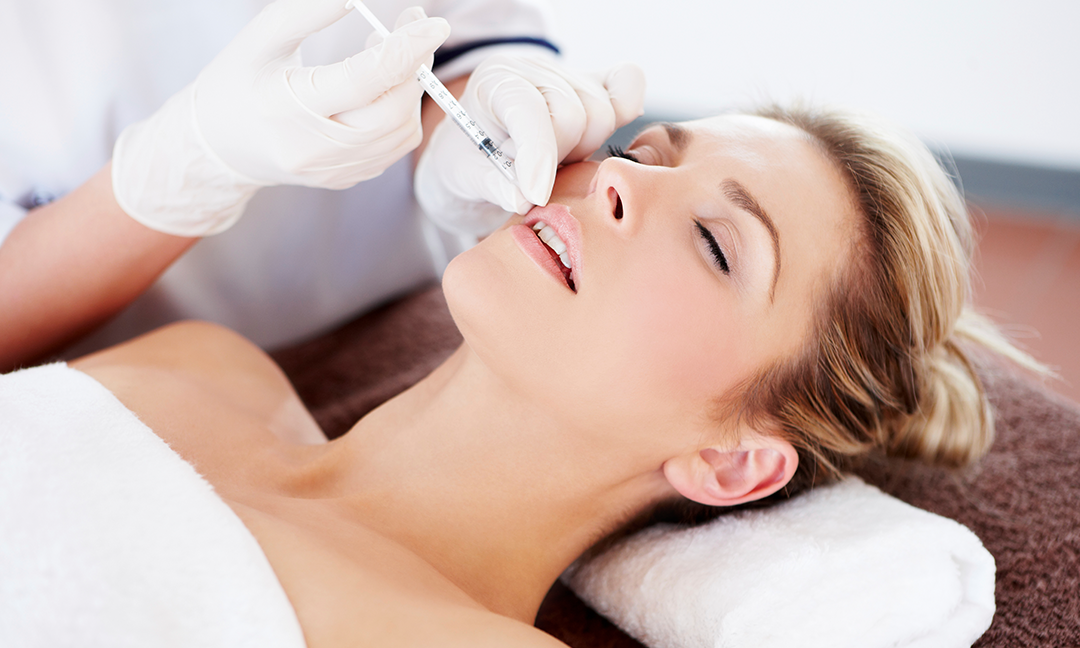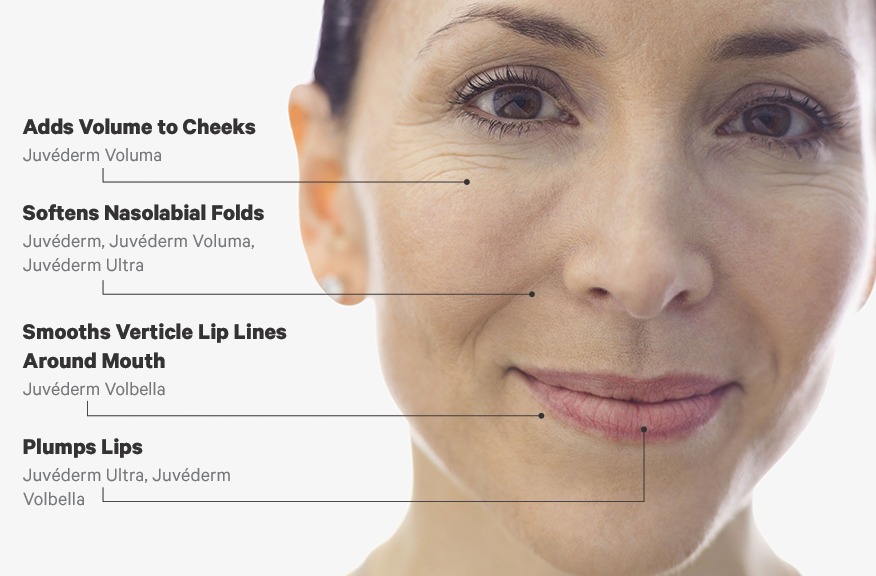Juvéderm FAQs: What It Does, Cost & More
If you've noticed lines and other telltale signs of aging appearing on your face, you've probably wondered what you can do to halt their advance. And if you've fallen down an Internet hole researching ways to do this, you may have discovered that dermal fillers can temporarily correct these signs of aging. One such facial filler is Juvéderm.
We spoke with Dr. Kathryn J. Russell, a dermatologist and Mohs surgeon at the Woodruff Institute in southwestern Florida, to gain an expert's insight into what Juvéderm is, how it's different from other wrinkle fillers, and why we're even showing those signs of aging in the first place.
To get started, click on one of the questions below.
- What is Juvéderm?
- How does Juvéderm work?
- What are the treatment areas?
- What type of Juvéderm do I need?
- How much Juvéderm do I need?
- How much does Juvéderm cost?
- How is Juvéderm different from other injectables?
- Why choose Juvéderm?
- When will I see results?
- Can I get multiple treatments?
- Am I eligible for Juvéderm?
- What are the side effects of Juvéderm?
What is Juvéderm?
Juvéderm is a facial filler that plumps up skin to get rid of wrinkles. It also plumps up lips.
Specifically, "Juvéderm is a non-animal, cross-linked, hyaluronic-acid-based filler that works by restoring volume to the face," Dr. Russell says. "It literally is used to fill [the face's] folds and creases."
Hyaluronic acid is a naturally occurring substance in your body. It adds lubrication to joints and a cushion-like effect to the skin and tissues.
How does Juvéderm work?
It replicates hyaluronic acid, and by being injected into the skin, Juvéderm temporarily restores the skin's support structure and smooths out wrinkles. Dr. Russell says, "it works best to treat the wrinkles and lines of the 'resting face.'"
Treatment areas
Which type of Juvéderm do I need?
Your provider will decide which one is best for you. However, here is a general guide to the different types:
|
TYPE |
BENEFITS |
LASTS |
GOOD TO KNOW |
|
JUVÉDERM ULTRA XC |
Plumps lips AND/OR softens moderate to severe nasolabial folds |
Up to 1 year |
Good for bigger lips |
|
JUVÉDERM VOLBELLA XC |
Subtly plumps lips while smoothing vertical lip lines around the mouth |
Up to 1 year |
Good for subtly bigger lips |
|
JUVÉDERM VOLUMA XC |
Adds volume to cheeks with a deep injection |
Up to 2 years |
Typically for adults age 35 and older |
|
JUVÉDERM XC |
Softens moderate to severe nasolabial folds |
Up to 1 year |
The OG Juvéderm, it was first approved by the FDA in 2006 |
|
JUVÉDERM VOLLURE XC |
Softens moderate to severe nasolabial folds |
Up to 18 months |
Newest Juvéderm option and lasts the longest of the wrinkle-smoothing Juvéderms |
Note: XC indicates that there is lidocaine in the syringe to help make the injection less painful.
While reading about all these types of Juvéderm might leave your head spinning, Dr. Russell notes that their differences lie in their hyaluronic-acid concentrations, the way the hyaluronic acid is cross-linked, and their viscosities.
"Different products are better for different areas, and it also depends on the structure of the patient," she says.
Can I get Juvéderm anywhere else?
An injector may also use Juvéderm on areas not listed above, such as "the lines from the mouth to the chin (melomental folds), hands, temples, tear troughs, etc.," Dr. Russell says. These areas deviate from the manufacturer's approved areas of use, and injecting them is known as using Juvéderm "off-label."
Dr. Russell says that "most experienced injectors will deviate from the on-label applications of the Juvéderm products. The ideal product for your needs is best determined during a consultation."
How much Juvéderm do I need?
Patients typically need between one and two syringes of Juvéderm for one area, but may need three or four. How much you need exactly depends on various factors, including age, depth of wrinkles, your end goal, etc. Your doctor can tell you how many syringes you'll need to achieve a good result during your consultation.
If you buy one of our deals and are not satisfied with the answer during your consultation, we will honor your refund request.
How much does Juvéderm cost?
Typically, a Juvéderm treatment will cost about $450–$600 per syringe. However, one our site, you can find Juvéderm treatments for less than $400.
Click here to find Juvéderm treatments near you.
How is Juvéderm different from other injectables?
Different injectables treat different signs of aging.
Some lines and creases are noticeable when we're sitting still, perhaps reading a book or watching TV. Others become apparent when the face is in motion—when we're talking and laughing.
This distinction has given rise to two types of injectables:
-
For wrinkles when face is at rest: Dermal fillers, like Juvéderm
-
For wrinkles when face is in motion: Neuromodulators, such as Botox and Dysport
"Neuromodulators are used to relax muscles that cause wrinkles with movement," Dr. Russell says. "Fillers are used to restore volume and correct wrinkles at rest."
Why choose Juvéderm over other dermal fillers?
If you're new to the wrinkle-filler scene, you might be wondering what other fillers are out there. Dr. Russell also uses:
-
Hyaluronic-acid fillers similar to Juvéderm, including Restylane, Restylane Silk, Restylane Lyft, Restylane Refyne, and Restylane Defyne
-
Non-hyaluronic-acid fillers such as Radiesse and Sculptra
When asked why she might choose Juvéderm over these other options, Dr. Russell points to Juvéderm's quality: "Juvéderm products have a great safety profile and provide reliable results."
When will I see results?
Usually the same day. There may be some swelling, which can cause the area to look fuller at first, but that swelling should resolve itself within a week.
Can I get multiple treatments?
It's not uncommon for patients with multiple concerns to receive more than one treatment in the same day. Dr. Russell says that she often likes to treat the cheeks first in such cases, restoring the face's structure—its "scaffolding"—before she works her way down to the lower face.
Am I eligible for Juvéderm?
Most adults are eligible for Juvéderm (the manufacturer doesn't recommend it for anyone younger than 21).
According to the manufacturer, you should not get Juvéderm if you:
-
Have a history of multiple severe allergies or severe allergic reactions (anaphylaxis), or if you are allergic to lidocaine or the Gram-positive bacterial proteins used in these products
-
Have an infection at the injection site
Inform your doctor if you:
-
Are pregnant or breastfeeding. It is not known if Juvéderm can harm an unborn baby or pass into breast milk.
-
Have a history of excessive scarring or pigmentation disorders, as the use of Juvéderm may result in additional scars or pigmentation changes
-
Plan to get other laser treatments or a chemical peel. There is a risk of inflammation at the treatment site if you get one of these procedures right after you get Juvéderm.
-
Are on immunosuppressive therapy, as there may be an increased risk of infection
-
Are using medications that can prolong bleeding, such as aspirin, ibuprofen, or other blood thinners
If you have other conditions, it is best to consult with your doctor before getting Juvéderm.
What are the side effects of Juvéderm?
Common side effects include:
-
Redness
-
Swelling and tenderness
-
Itching
-
Bumps and bruising at the injection sites
-
Dryness (particularly with Volbella)
One of the more serious risks is unintentional injection into a blood vessel. Though it is rare, the complications can be serious and may be permanent. These complications, which have been reported for facial injections, can include vision abnormalities, blindness, stroke, temporary scabs, or permanent scarring.
Read all of the safety considerations for Juvéderm here.
Sources
The information contained in this article is from an interview with Dr. Kathryn J. Russell and Juvéderm's website.
RELATED READS
 What Is Botox: The Complete Guide
What Is Botox: The Complete Guide This guide will take you beyond the basics of Botox injections, step by step.
 What Is Dysport and How Does It Work?
What Is Dysport and How Does It Work? Dysport can help improve the appearance of lines by paralyzing the muscles that form them. Read on to learn all about the wrinkle-fighter.
 Restylane FAQs: Cost, Results, Side Effects & More
Restylane FAQs: Cost, Results, Side Effects & More One way to enhance your lips, smooth out wrinkles, or add fullness to the face is by using Restylane.
Juvéderm Deals









